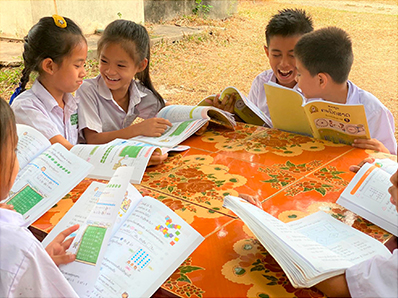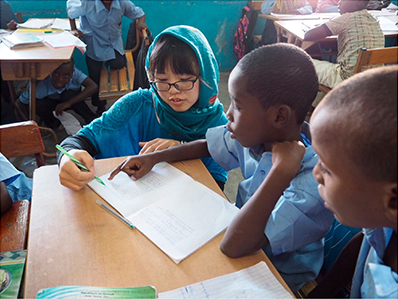(3) Quality Education for All
There are as many as 58 million children who cannot go to elementary school worldwide. When including secondary school, it is estimated that there are approximately 256 million out-of-school children (16.8% of the total). Note 62 In particular, the percentage of children who cannot go to school has increased since 2000 in Sub-Saharan Africa. Above all, children with disabilities, children of minority ethnic groups or those in disadvantaged communities, children of refugee and displaced people, and those living in remote areas are at the greatest risk of being left behind. The impact of the spread of COVID-19 has also been significant. In addition to the loss of learning opportunities due to school closures, it is pointed out that some children do not return to school even after reopening. These situations raise further concerns about malnutrition, early marriage, and gender inequality of those children.
SDG 4 aims to “Ensure inclusive and equitable quality education and promote lifelong learning opportunities for all,” and the international community works on achieving the goal of “Education 2030 Framework for Action.” Glossary
● Japan’s Efforts

Children studying with a math textbook created with Japanese assistance in the technical cooperation “Project for Improving Teaching and Leaning Mathematics for Primary Education,” in Laos (Photo: JICA)

A JOCV teaching the four basic arithmetic operations at an elementary school in Dikhil Region, Djibouti (Photo: JICA)
Japan provides developing countries with a broad range of support, including the enhancement of basic education, Note 63 higher education, and vocational training.
Japan promoted its “Education x Innovation” initiative, Note 64 which was announced in 2019, and met its commitment by supporting approximately 9.47 million children and youths over the three-year period. In order to allow all children to complete quality elementary and secondary education by 2030, it is essential to encourage innovation to accelerate assistance. Through the “G20 Initiative on Human Capital Investment for Sustainable Development” (G20 Osaka Summit 2019), Japan further strengthens support for education that improves basic academic skills, STEM education, Note 65 and development of e-learning, among others (see “Project Introduction Column” for Japan’s efforts in Nepal).
Also, Japan contributed a total of approximately 46.62 million US dollars from 2008 to 2022 to the “Global Partnership for Education (GPE).” Glossary Since 2015, the number of children supported by partner countries of GPE has reached approximately 32.7 million, and three out of four have finished elementary education. At the Global Education Summit held in July 2021, Japan pledged to contribute more than 1.5 billion US dollars over five years from 2021 to 2025 to support the education sector, including continued support for GPE, as well as the support for the education and human resources development of 7.5 million girls in developing countries.
At TICAD 8 Note 66 held in August 2022, as an initiative in the field of education (human resources development including youth and women) for Africa, Japan expressed that it would help improve children’s learning by promoting school enrollment, improving inclusiveness, and providing school meals through initiatives such as the “School for All” project. Japan also announced that, through these efforts, it aims to eventually provide quality education, including STEM education, to 9 million children and improve access to quality education for 4 million girls. In addition, through human resources development and acceptance of international students under the Japan-Africa university network, Japan works to develop highly-skilled human resources, including those in the fields of science and technology (see “Stories from the Field 3” for Japan’s support in Egypt).
With a focus on Niger and other West African countries, Japan has implemented the “School for All” project since 2004, which aims to build relationships of trust between schools, parents and guardians, and local residents, as well as to improve the education environment for children. In cooperation with the World Bank, GPE, and others, Japan works to expand the project throughout each targeted country. 70,754 elementary schools in nine countries have introduced the program as of October 2022.
In the Asia-Pacific region, Japan provides assistance for initiatives toward the achievement of SDG 4. It includes support for organizing the “Asia-Pacific Meeting on Education 2030 (APMED2030)” annually through the contribution to a funds-in-trust within the United Nations Educational, Scientific and Cultural Organization (UNESCO), as well as support for improvement of education quality, enhancement of early childhood education, spread of non-formal education, and improvement of teachers’ teaching skills. Moreover, Japan supports human resources development in developing countries by engaging in a wide range of efforts such as strengthening networking among higher education institutions between Japan and ASEAN, collaborating with the industrial sector, participating in joint research projects with neighboring countries, and accepting international students to Japanese higher education institutions and other institutions.
■ Promoting Education for Sustainable Development (ESD)
“Education for Sustainable Development Glossary: Towards achieving the SDGs (ESD for 2030)” began in January 2020 with UNESCO as the leading organization. ESD can contribute to the realization of all SDGs by fostering the builders of a sustainable society, and Japan, as the country that proposed ESD, continues not only to engage in the promotion of ESD but also to play a significant role in its global advocacy and enhancement through the funds-in-trust to UNESCO. In addition, through the aforementioned funds-in-trust, Japan actively promotes ESD by implementing the “UNESCO-Japan Prize on Education for Sustainable Development” together with UNESCO, honoring organizations and institutions that conduct excellent initiatives toward putting ESD into practice. 18 organizations have been awarded to date.
Glossary
- Education 2030 Framework for Action (FFA)
- A framework for action that succeeds “The Dakar Framework for Action: Education for All,” aimed at achieving education for all and adopted at the “World Education Forum” in Dakar, Senegal in 2000. The FFA was adopted at the “Education 2030 High-Level Meeting,” which was held to coincide with the UNESCO General Conference in 2015.
- Global Partnership for Education (GPE)
- An international partnership established under the leadership of the World Bank in 2002, which supports the education sector in developing countries. Its members include developing countries, donor countries and organizations, civil societies, and private-sector corporations and foundations. It was renamed GPE from Fast Track Initiative (FTI) in 2011.
- Education for Sustainable Development (ESD)
- Education that fosters builders of sustainable societies. ESD was affirmed as being the key for achieving all the SDGs in the resolutions of the 72nd Session of the UN General Assembly in 2017. This was reaffirmed in the “ESD for 2030,” adopted by a resolution of the 74th Session of the UN General Assembly in 2019. “ESD for 2030” is a succeeding program of the “United Nations Decade of Education for Sustainable Development (UNDESD) (2005-2014)” and the “Global Action Program (GAP) on ESD (2015-2019),” and is a new international framework for the implementation from 2020 to 2030.
- Note 62: Pages 209, 413, and 427 of the “Global Education Monitoring Report 2021/2.”https://unesdoc.unesco.org/ark:/48223/pf0000379875
- Note 63: The educational activities designed to enable individuals to acquire knowledge, values, and skills necessary to live. It mainly refers to elementary education, lower secondary education (equivalent to Japanese junior high schools), pre-school education, and adult literacy education.
- Note 64: Based on the “G20 Initiative on Human Capital Investment for Sustainable Development” announced at the G20 Osaka Summit in 2019, this unique initiative of Japan was announced to provide education for innovation and education through innovation to at least approximately 9 million children and young people over the three years from 2019 to 2021.
- Note 65: STEM is an acronym for Science, Technology, Engineering, and Mathematics, and refers collectively to these four educational fields.
- Note 66: See “ODA Topics.”
